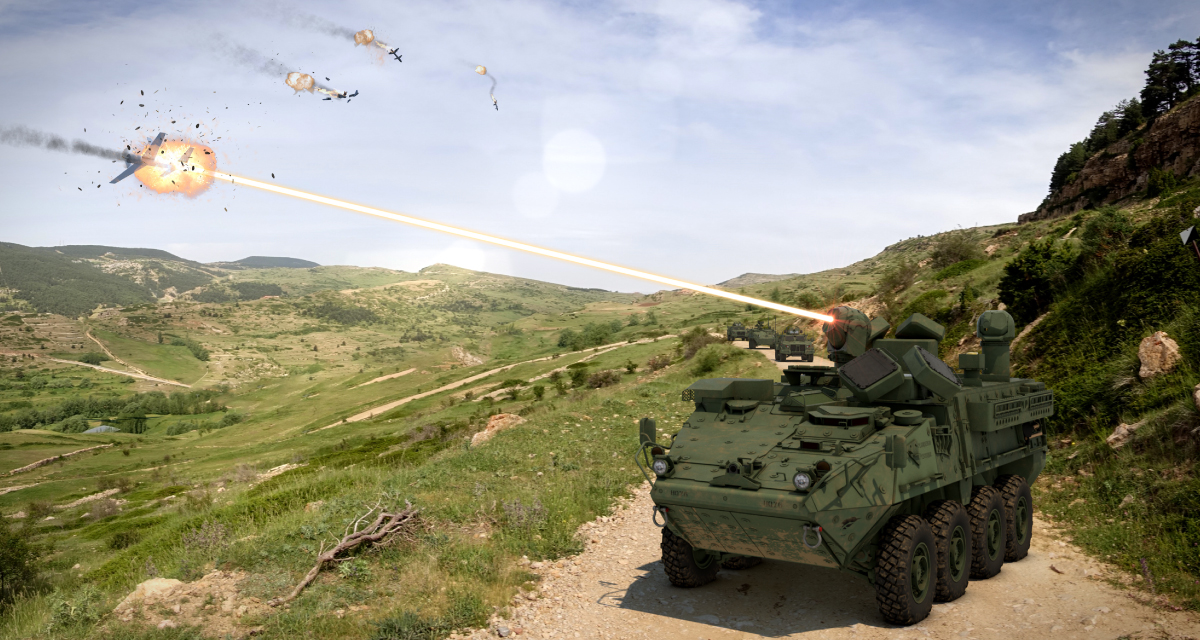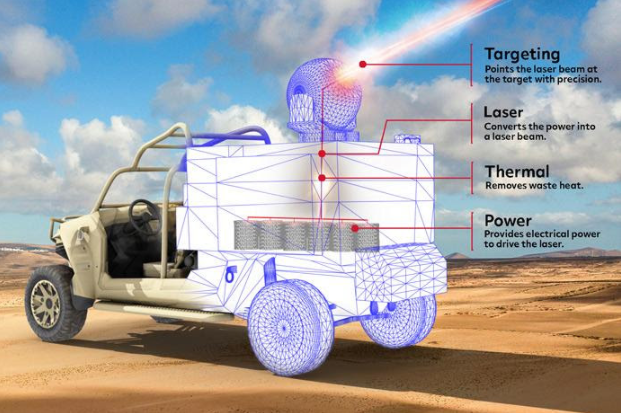
A small quadcopter, just like the ones they sell for a few hundred dollars at big-box stores, flies against a cloudless blue sky. On the ground, atop a dune buggy, a glass-paned turret pivots in the drone’s direction.
Inside the vehicle, there’s a motorized whirr. Moments later, flames start to flicker near a microscopic hole in the center of the drone’s wings, and the hard plastic begins to melt. A few seconds later, it crashes to the ground.
This is what it looks like when , a Raytheon Technologies business, demonstrates the use of lasers to defeat hostile drones. Counter-UAS lasers such as RI&S’ give military service members and public-safety officials a relatively inexpensive way to defeat swarms of cheap, weaponized drones.
The Raytheon Intelligence & Space High-Energy Laser Weapons System offers a cost-effective counter-UAS solution rather than firing a multi-million dollar missile to disable a $500 commercial quadcopter. Furthermore, commercial, small drones have become much more sophisticated, fly faster and can navigate autonomously without using radio frequencies, making them jam-resistant.
Here’s how they work
Every laser – no matter whether it’s scanning groceries at the supermarket or reading a Blu-Ray DVD – starts with the same idea: converting electricity into light.
“By far and away, semiconductor diode lasers are the most common way to convert energy – electricity – into photons or light,” said Iain McKinnie, Electro-Optical/Infrared and Laser Technologies technical director for RI&S.
But diodes alone can’t take down a drone.
Semiconductor diode lasers spread out and diffuse over distances, which, on their own, makes them ineffective for disabling drones.
“Think of a garden hose nozzle that is set to a wide spray,” McKinnie said. “Only about 50% of the electrical power gets converted into laser light and the other 50% is waste heat. We needed a second stage to convert the semiconductor diode laser light into laser light that we can use in our counter-UAS system. We do that with fiber, turning that wide spray into a concentrated, narrow jet.”
Diode lasers are only step one, serving as a “pump” for a fiber laser.
“Diodes are the core building block in a fiber laser amplifier. Within that amplifier, a number of diodes pump their light into a single optical fiber, which produces a very powerful and perfectly formed beam,” said Evan Hunt, director of business development for High Energy Lasers and Counter UAS at RI&S.
Getting enough fiber
The fiber optic cables used in RI&S’ High-Energy Laser Weapons System are very similar to those the telecommunications industry uses – only they can withstand much higher power levels, and the HELWS fiber optic cable is about 10 times wider, at a microscopic level, than the cables used by the telecom industry.
“Fiber-based lasers have become elegant, efficient and pretty robust because of the research, investment and support they’ve received by the very large commercial industry of cutting and welding,” Hunt said. “They are 40-50% efficient, generating very little heat. And in addition to the efficiency, the fiber serves to amplify the power of the beam.”
Fiber lasers use a lot of cabling that can run from tens to hundreds of meters long, according to McKinnie, and because of this bulk, the cabling is “spooled up like fishing wire” so it can fit onto a mobile platform and also aids in distributing excess heat.
The fiber laser beam is much more focused than diode lasers. “Instead of a flashlight, you have a laser pointer,” Hunt said. And unlike the red, green or violet beams emitted by common laser pointers, HELWS produces laser light in the infrared spectrum that’s invisible to the naked eye.
Crossing the beams
But a single fiber laser beam does not provide the range and engagement speed to destroy an attacking drone. The third stage is combining multiple fiber laser amplifier beams.
“It’s incredibly difficult to manage such powerful light and the associated heat within such a small system,” said Justin Martin, HELWS chief engineer. “The optics need to be precisely aligned and specially coated so they don’t melt upon contact.”
Once that powerful beam is built, the laser needs a way to find its target.
To accomplish this crucial step, RI&S equipped the system with its Multi-Spectral Targeting System, or MTS, which uses light from many bands of the electromagnetic spectrum to acquire and track targets, and then tell the operator where to fire the laser.
MTS is used on more than 20 rotary-wing, unmanned aerial systems and fixed-wing platforms for long-range surveillance, target acquisition, tracking, range finding and laser designation.
Illustration shows the four core subsystems of RI&S’ high-energy laser weapon system.
Drones in the crosshairs
Raytheon Intelligence & Space’s area of expertise is in electro-optical infrared sensors like MTS. The company modified it not only to sense the target, but to actually point the beam at and engage the target. The specific thing the operator is zooming in on, looking at and optically tracking is exactly where the invisible beam hits when triggered, silently burning a hole in it within a few seconds.
“The most powerful laser beam in the world is useless if the operator can’t find it and fix it on its target,” Hunt said.
The system has a range of a few miles, and operators use a video game controller to point the system toward the target, identify the drone, tell it apart from its surroundings and mark a place for the laser to hit. The system is so precise it allows operators to put crosshairs directly on a drone’s camera, for example – giving them the option to neutralize the threat without sending the aircraft plummeting to the ground.
“The optical system is so powerful, so high resolution that operators can identify and track the smallest drone well beyond visual range even in cluttered environments,” said Martin. “This also enables operators with situational awareness of a drone’s surroundings so they can determine the best place to take down the target.”
The system is modular, meaning it can be easily customized to fit on multiple platforms, and it is compact – small enough to mount in the bed of a pickup truck.
“I always say it’s four boxes and a ball,” said Hunt. “We’ve got two power boxes with the latest and greatest battery technology that come from the commercial electric car industry. One powers the system power and the other serves as the energy magazine for laser results. Then we have a box with all the fiber laser coils, and we have a thermal management module, which recirculates water through the system. And finally, we have the beam director, the turret, sitting on top with the optical module.”
HELWS hits exactly where the operator aims and at the speed of light. It has a deep, rechargeable magazine with the potential for unlimited shots. Once the batteries begin to deplete, the system can be switched over to a generator to keep it up and running.
“The idea behind the system is to be able to detect, ID and engage these things well before they become an imminent threat,” Hunt said. “And it does that very well.”

No comments:
Post a Comment